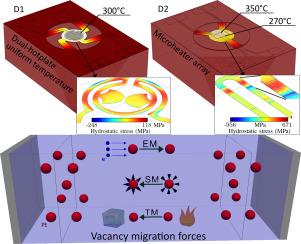Microelectronics Reliability ( IF 1.6 ) Pub Date : 2021-07-12 , DOI: 10.1016/j.microrel.2021.114219 Lado Filipovic 1

|
Conductometric gas sensors based on SMO films must be heated to temperatures up to 550 °C in order to initiate the molecular adsorption process at the SMO film's surface. Very often platinum is used as the microheater material. The long-term reliability of these devices are primarily associated with the mechanical stability of the micro-electro-mechanical systems (MEMS) structures used to hold the microheater suspended and thermally isolated from other integrated components, such as analog and digital circuitry. However, previous studies have shown that that electro-migration and thermo-migration phenomena could potentially exacerbate the stress build-up in platinum microheaters and contribute to their eventual failure. In this manuscript we propose a means to quantify the impact of vacancy transport on stress build-up in two novel microheater designs under electro-migration and thermo-migration phenomena. The first design is aimed at improved temperature uniformity and the second is aimed at microheater array operation, taking advantage of high temperature gradients to simultaneously provide multiple temperatures at different sensor locations. Our analysis shows that the thermo-migration force is much higher than the electro-migration force, meaning that the high thermal gradients in these devices contribute far more to vacancy transport than the atom transport induced by the electron wind. Furthermore, we calculate that our proposed designs are highly resistant to failure due to vacancy migration by calculating the mean-time-to-failure to be on the order of 1015 seconds under typical operating conditions.
中文翻译:

新型铂微加热器热迁移的理论研究
基于 SMO 薄膜的电导气体传感器必须加热至高达 550 °C 的温度,以便在 SMO 薄膜表面启动分子吸附过程。铂金经常被用作微型加热器材料。这些设备的长期可靠性主要与微机电系统 (MEMS) 结构的机械稳定性有关,该结构用于将微型加热器悬挂起来并与其他集成组件(例如模拟和数字电路)进行热隔离。然而,之前的研究表明,电迁移和热迁移现象可能会加剧铂微型加热器中的应力积累,并导致其最终失效。在这份手稿中,我们提出了一种量化空位传输对电迁移和热迁移现象下两种新型微型加热器设计中应力积聚的影响的方法。第一种设计旨在提高温度均匀性,第二种设计旨在实现微加热器阵列操作,利用高温梯度在不同传感器位置同时提供多个温度。我们的分析表明,热迁移力远高于电迁移力,这意味着这些器件中的高热梯度对空位传输的贡献远远大于电子风引起的原子传输。此外,我们通过计算平均故障时间约为 10,计算出我们提出的设计对由于空位迁移而导致的故障具有很强的抵抗力在典型操作条件下为15秒。











































 京公网安备 11010802027423号
京公网安备 11010802027423号